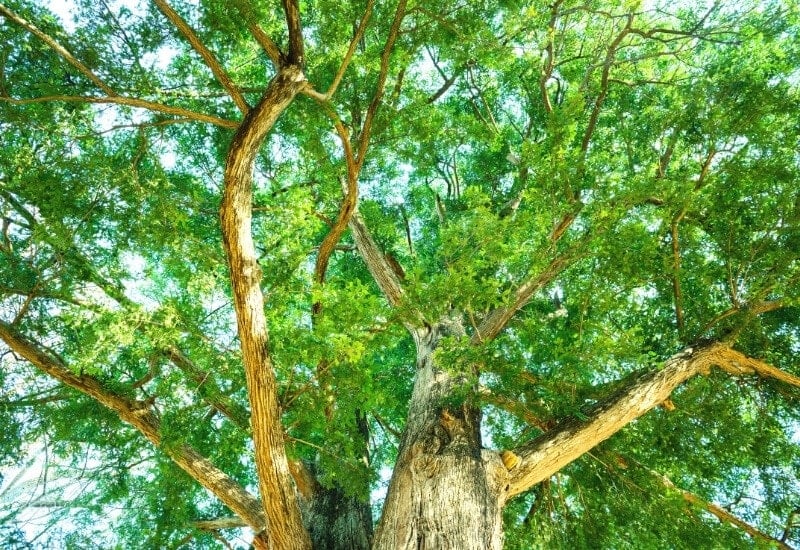
Evergreen trees bring life to the landscape even in the coldest months. In the growing season, it is easy to dismiss evergreens as just another “green” in the landscape.
But once the deciduous trees discard their leaves, they take on a bare and lifeless appearance. The evergreens remain, displaying beautiful colors and textures.
Winter is when evergreens stand out. But the truth is, all types of evergreen trees offer visual appeal in all seasons.
Evergreens are also a quite useful addition to the landscape. They are great for year-round privacy screens and windbreaks.
Overall, evergreen trees are reliable. You may plant them to serve a functional role, or just to admire them. Either way, you can count on the consistency of evergreen trees.
Each different evergreen tree has a unique set of characteristics. When it comes time to select an evergreen tree, knowing their benefits is just the beginning. Choosing the right evergreen tree for your landscape proves to be a daunting task.
Read on to learn about different types of evergreen trees and how to identify them.
Choosing Evergreens for Your Landscape
Choosing between types of evergreen trees is like selecting any other type of plant. The process mainly relies on two questions.
Different types of evergreen trees look alike. And they often share some growing preferences as well.
For instance, many evergreen trees require high amounts of sunlight. They also tend to grow best in acidic soils.
Many of these trees grow too large mature sizes as well. So, make sure you provide plenty of space for your evergreen tree to expand over the years.
After knowing about growing requirements, you next need to know the role your evergreen tree will play on your property.
Are you planting an evergreen tree for privacy, or for aesthetics?
Your answer to that question will be a major factor in the species you end up choosing.
Lastly, your personal preference is always important. You’ll find that evergreen trees have differences in texture, shape, and color.
At times you’ll find the differences to be subtle, and other times they are stark. It is up to you to decide which features you prefer.
How Do You Identify Evergreen Trees?
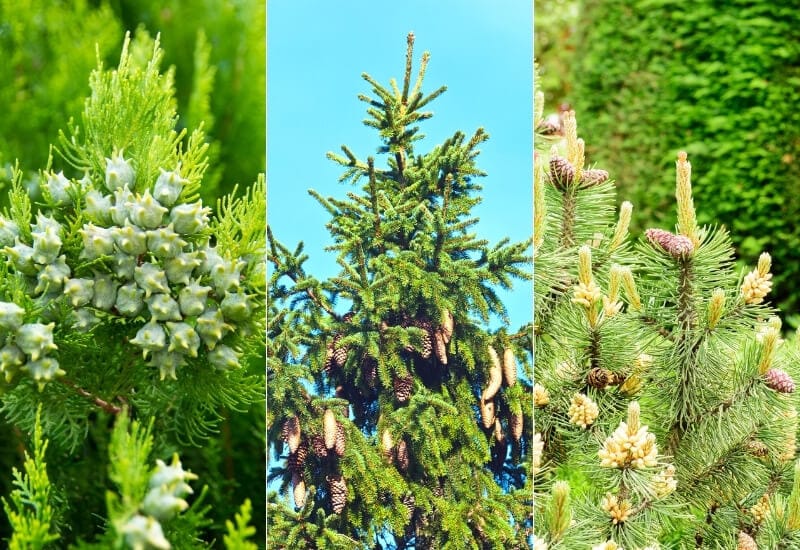
The most obvious way to identify evergreen trees is to take a look at them in winter. The defining characteristic of these plants is that they will maintain their foliage while other trees lose all their leaves.
Telling an evergreen tree from a deciduous tree is relatively easy. Telling between evergreen trees is the challenge.
It is possible to identify different evergreen trees like pines, spruces, and firs by looking closely at their needles and cones. For example. White pines hold their needles in groups of five. The needles of spruces and firs are usually attached singularly.
To distinguish between species, here is a quick breakdown of the traits you should evaluate.
Evaluating each of these takes a more trained eye. But for each plant on this list, we will include some essential identification guidelines.
But before we profile individual species, let’s take a broad view of the larger categories of evergreen trees.
Types of Evergreen Trees
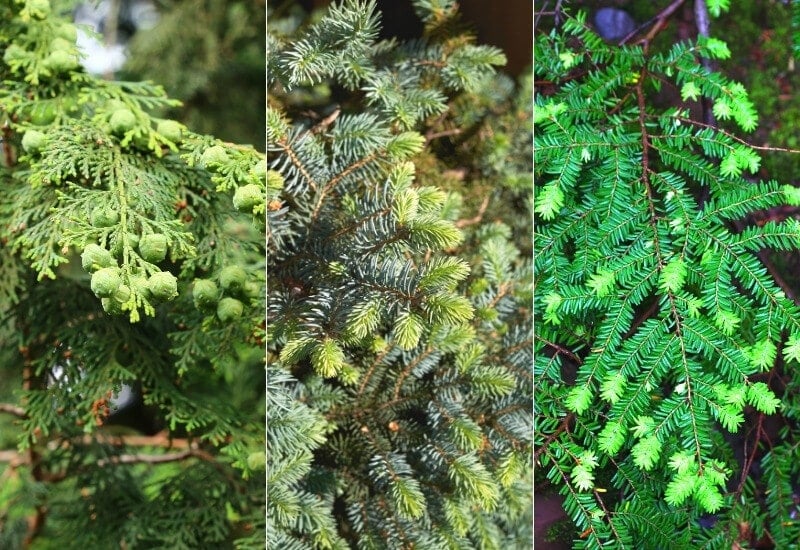
There are many types of evergreen plants including both trees and shrubs. Evergreens include most species of conifers including…
But not all conifers are evergreen. One common exception is the larch tree. Larches have needles like all conifers. However, unlike other conifers, larches drop their needles in the fall.
The majority of evergreen trees have needles. But you may be surprised to find that there is an alternative.
In addition to the needle-bearing conifers, there are many broadleaf evergreens. Broadleaf evergreens are a bit different in their appearance. These trees have foliage that is wide and flat like a deciduous tree.
The difference is that these broad leaves remain on the tree rather than falling. They are also usually thicker than deciduous leaves. There are a few broadleaf evergreens on this list. But most popular broadleaf evergreens are shrubs rather than trees.
Some examples of broadleaf evergreens are below.
Another way to group evergreens is by size. Those that grow in nature, and many cultivars, grow to massive heights.
But there are many dwarf varieties of evergreen trees. These often have interesting growth habits on display in more ornamental planting schemes.
There is a large group of dwarf ornamental conifers that horticulturalists have added to over the years through hybridization.
Now that you have some general knowledge about evergreen trees, its time to learn about some of the best species.
16 Varieties of Evergreen Trees
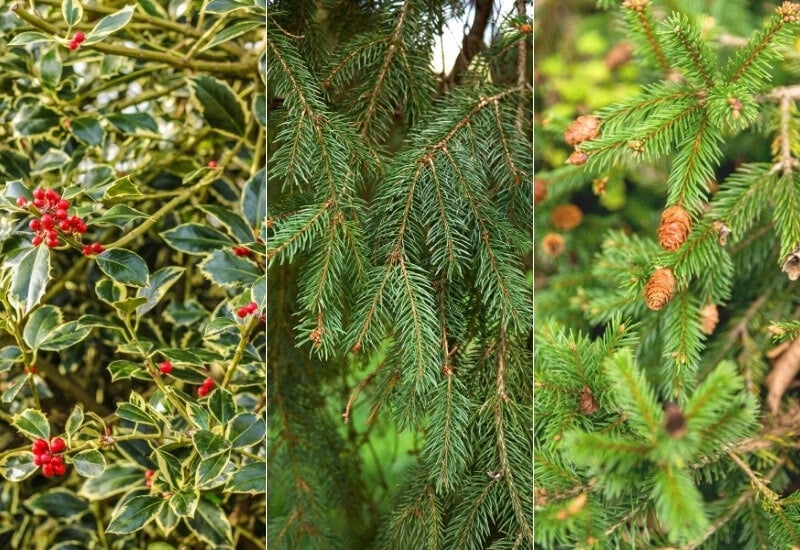
The evergreen trees listed here are some of the best options around. In each section, you will see what makes each plant a special addition to the landscape. You will also get to know how to identify, plant, and care for these trees.
To help you have a better knowledge of evergreen trees, this article is organized based on some common groups of evergreen trees. Within each of those groups are two of the best species.
Pine Trees
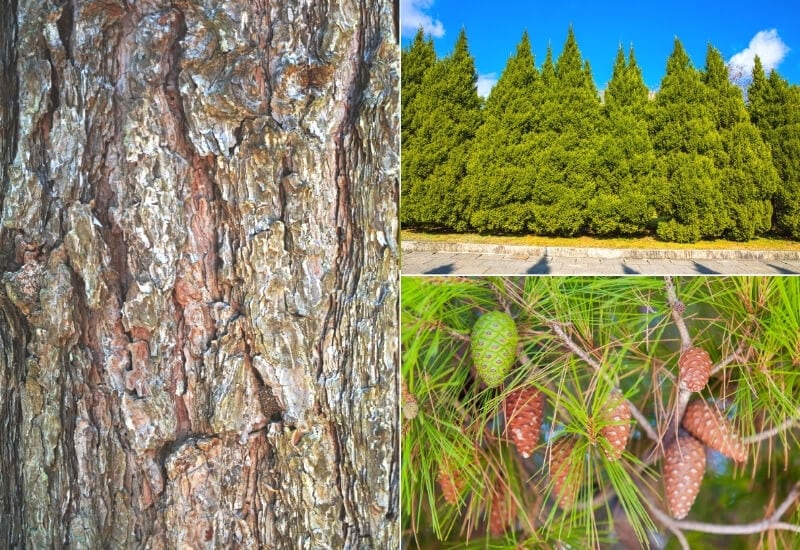
Pine is likely the most recognizable name among evergreen trees. People use the term so frequently that they often refer to almost all evergreens as pines.
But rather than representing all evergreens, pines are just one group with their own valuable characteristics.
These trees generally large trees with long needles. Read on to learn about some fantastic varieties.
Pinus Strobus (Eastern White Pine)
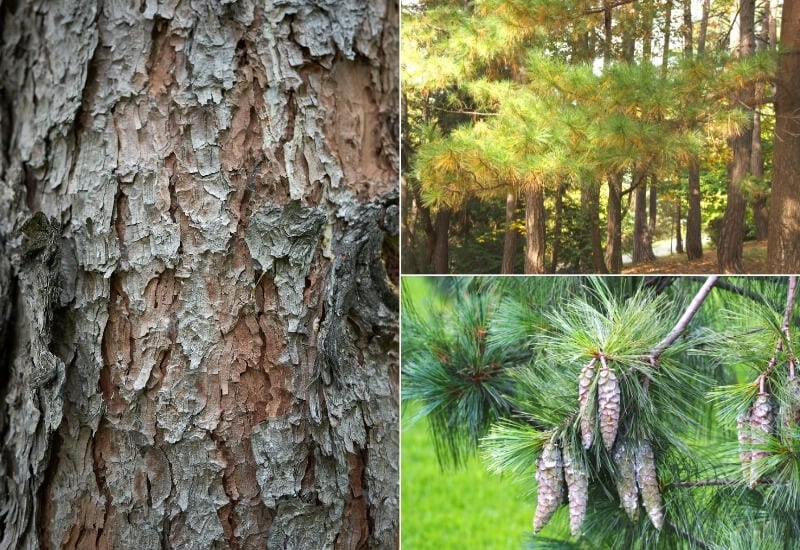
Eastern white pine is one of the most prominent trees in the eastern United States. These trees grow quickly and in abundance. In many regions, they are one of the primary species comprising the forest.
This tree begins with regularity in its form. As eastern white pine grows, it often loses its symmetrical form. At maturity, the shape is somewhat irregular, especially the crown.
Eastern white pine has needles that are long, soft, and green with a slight blue tint. Each year, the oldest needles turn brown and fall. However, this accounts for a minuscule percentage of the foliage. Overall, the needles are completely green.
This species of pine has served a variety of uses throughout time. In the past, the trunks made for good ship masts. Also, the needles contain vitamin c. Boiling these needles makes for a decent natural tea.
Identification
Large fast-growing treeThin 2-4” needles held in sets of five3-7” cylindrical cones, often with a slight curve
Planting and Care
Plant white pine in acidic soil in plenty of sun. Prune when dormant, from late fall to early spring.
It is common for pine trees to let their lower branches die off. This is not a sign of a problem. If you don’t like the appearance of these dead branches, remove them as you see fit.
You can also trim white pine as a hedge. To do so, sheer exterior foliage to produce your desired form.
Pinus Rigida (Pitch Pine)
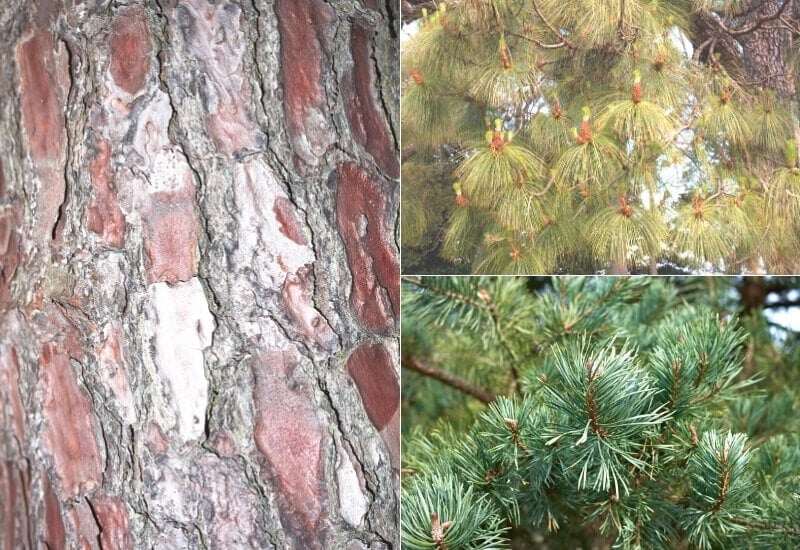
Pitch pine is a large coniferous tree with an irregular form. The branches can grow in twisting and dropping forms.
Despite being an evergreen, this tree shows some subtle color change. This occurs as the tree matures.
The foliage begins as a yellowish-green then turns dark green. The bark begins as reddish-brown then becomes nearly black.
Pitch pine produces resin. In the past, this resin was useful as an ingredient in axel grease.
People don’t typically plant this tree for its ornamental qualities. Instead, it is a good option for poor soil conditions.
Identification
Gnarled irregular formRigid 3-5” needles, sometimes slightly curvedSymmetrical cones, 2-3” long, 1-2” wide, held in sets of 3-5
Planting and Care
Pitch Pine is a good option for poor soils. It adapts to moist sandy soils. This is why it often near seashores in certain areas.
This tree can handle dry rocky soils as well. When soils prove to be too nutrient deficient for other evergreens, pitch pine is a good choice.
Give this plant plenty of sun. Don’t prune late in the season. Instead, do so in spring so the tree has time to heal the wound before harsh weather arrives.
Spruce Trees
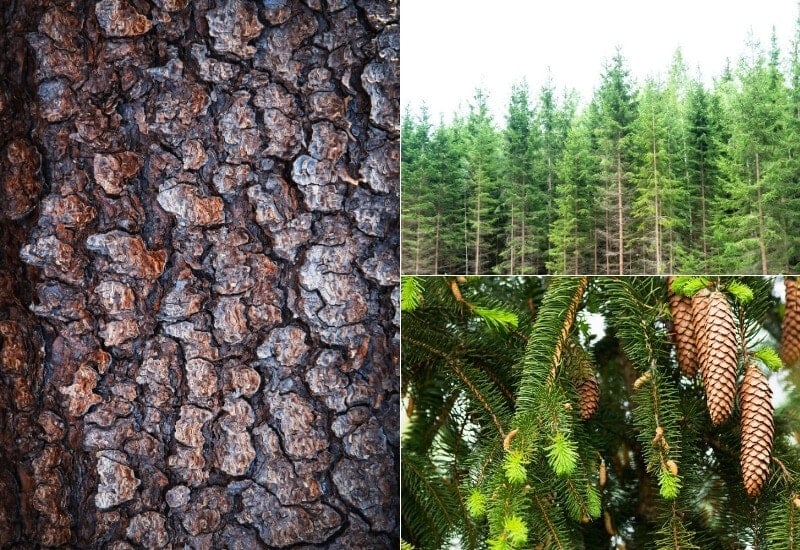
Spruce trees often feature a perfect pyramidal form. These trees are likely to grow to great heights at high elevations. Their needles are usually stiff and sharp. Below are two spruces with very different colors and branching habits.
Picea Pungens (Blue Spruce)
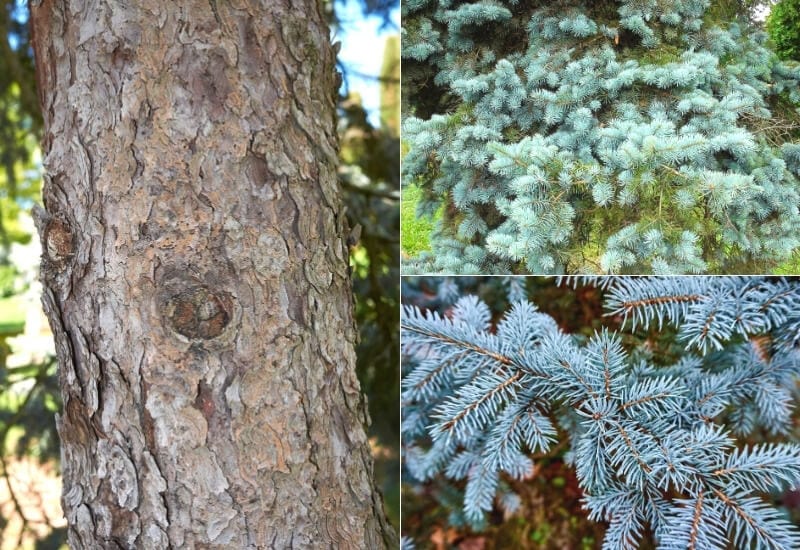
The best aspect of blue spruce is its striking color. This vibrant blue stands out all year round as it gives a stark contrast to the greens offered by other species. In the winter, it is especially noticeable.
Blue spruce also has a consistent pyramidal form. It maintains this Christmas tree-like shape throughout its life.
The needles of blue spruce are stiff and sharp. They cover the majority of each stem and are often painful to grasp.
Because of its colorful foliage, blue spruce makes for a great specimen tree. However, it can also grow as a part of a mass planting for privacy or wind screening.
Blue spruce also carries the name Colorado spruce. This is because it is native to the Rocky Mountains.
Identification
Planting and Care
Plant blue spruce in acidic soils with full sun. This species is tolerant of harsh winters up to zone 2.
Keep soil moist in youth. As this tree reaches maturity it can begin to tolerate dryer soils.
Not much pruning is needed since blue spruce has a consistent growth habit. Prune in early spring if you wish to control growth.
Picea Abies (Norway Spruce)
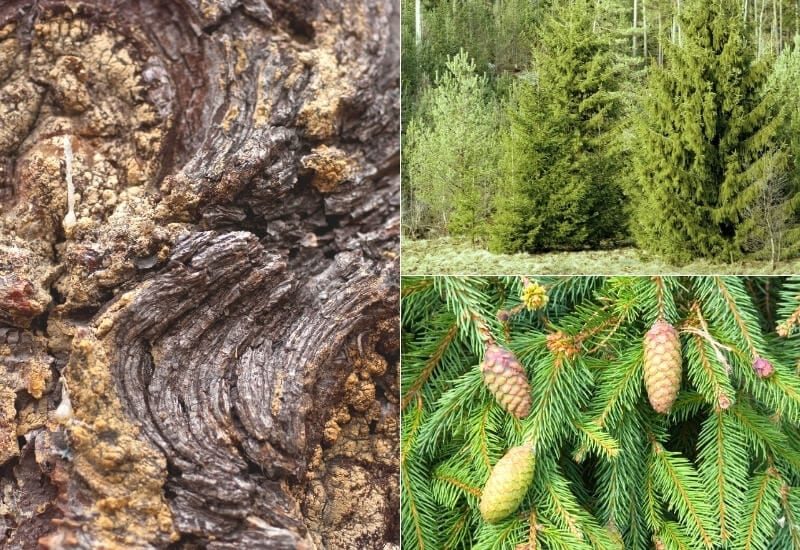
Native to central Europe, Norway spruce is a fast-growing conifer. This rapid growth rate is especially prevalent in youth. At maturity, these trees can reach around 75’ tall.
The branches of Norway spruce are pendulous. They continue to droop more as the tree ages.
The needles are usually around 1” long. They grow in all directions covering the entirety of each stem.
The cones are large and long. They are about 6-8” with a brown color. The hang in the same pendulous manner as the branches.
Identification
Planting and Care
Norway spruce is another good option for a privacy screen.
This tree has a shallow root system that performs best in moist acidic soil.
When planted in shade the branches can become sparse.
Prune in late winter. For those interested in a dense screen, consider clipping the central leader. This will promote more horizontal growth.
Fir Trees
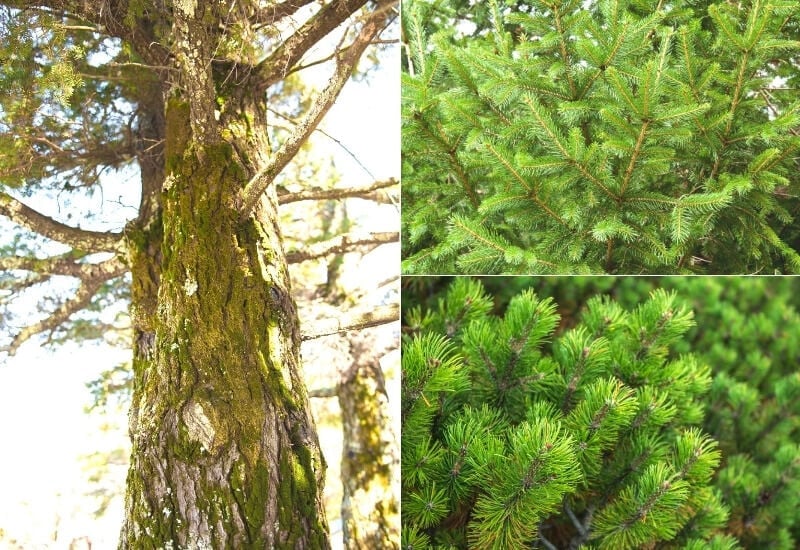
It is easy to mistake fir trees for spruces. Many species share the same Christmas tree-like shape. But the needles offer an easy way to tell the difference. While spruce trees are sharp, fir trees are soft. The fir trees listed here are both great evergreen tree options. One is a staple plant of the Pacific Northwest. The other offers vibrant foliage.
Pseudotsuga Menziesii (Douglas Fir)
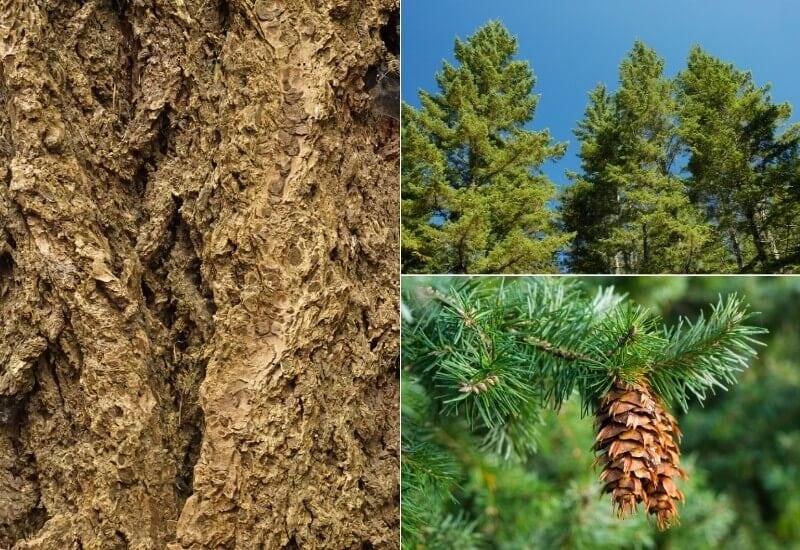
Douglas fir is a massive conifer that is native to the Pacific Northwest. It is one of the most prominent trees in the forests of this area. It can grow in low-lying coastal areas as well as higher mountain elevations
One of the best ways to identify this tree is by the bracts on its cones. These bracts are unlike those of any other conifer. They have a forked pointed shape like a v or a trident.
The needles are thin and short. They can be green to blue-green in color. Sometimes they have a shiny appearance as well.
This tree also has a unique branching habit. The mid-level branches are stiff, growing horizontally to the ground. The branches below droop downward, the branches above reach more towards the sky.
Overall, this tree has a medium growth rate. Its general form is somewhat loose but pyramidal.
Identification
Planting and Care
Douglas fir prefers acidic soil but can grow in neutral soils as well. It enjoys full sunlight.
This tree can be susceptible to disease and insects when not planted in ideal conditions.
Because of its extreme mature size, Douglas fir can be challenging to grow in residential settings. Prune in late winter to attempt to control the height.
Abies Concolor (White Fir)
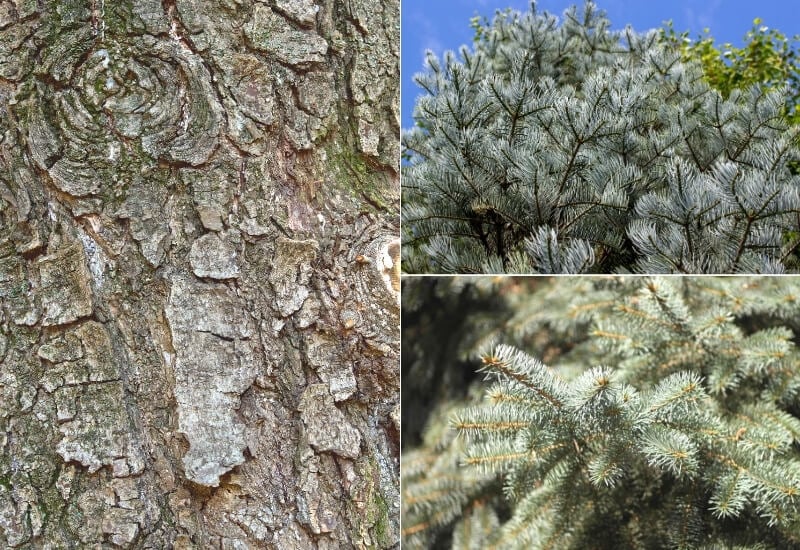
White fir is native to the mountain regions of the American West. They often grow in rocky soils. In those settings, it can grow much taller than in residential and commercial plantings.
White fir offers a consistent color that is similar to the color of blue spruce. The difference between the foliage of these two species is in the feel.
If you grab a white fir tree, you will find that the needs are soft and flexible. The needles of blue spruce are sharp and painful.
White fir is generally conical in form. It often has a thin central leader that sticks straight up out of the canopy like a spire.
Identification
Planting and Care
White fir is a victim of the wooly adelgid but not to the same degree as the Canadian hemlock.
Plant this tree where there is plenty of soil drainage and a good amount of sun.
White fir needs very little pruning. It tends to maintain one consistent form.
Cedar Trees
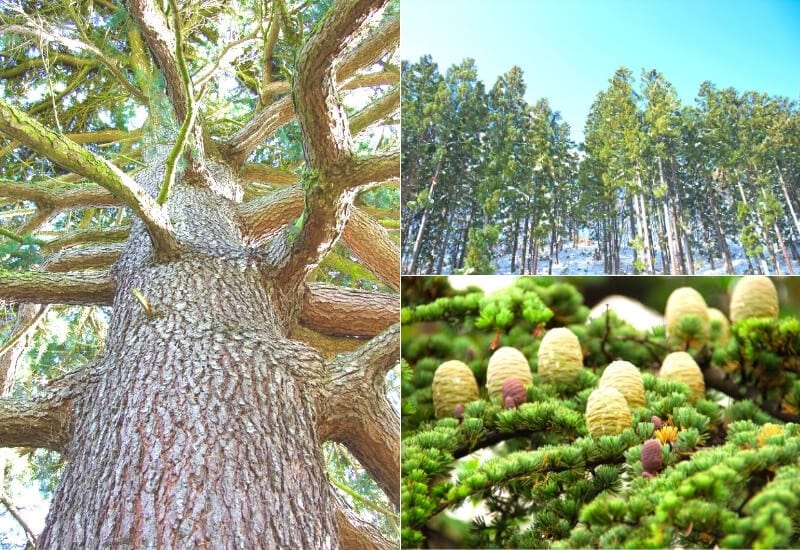
Cedar trees may be best known for the fact that they produce great wood for construction. But you will find that they have many other uses in the landscape as well. These trees make for some of the best privacy screens. While they are overplanted in some areas, it is for good reason. Their dense evergreen foliage effectively blocks both sight and wind.
Thuja Occidentalis (Eastern White Cedar)
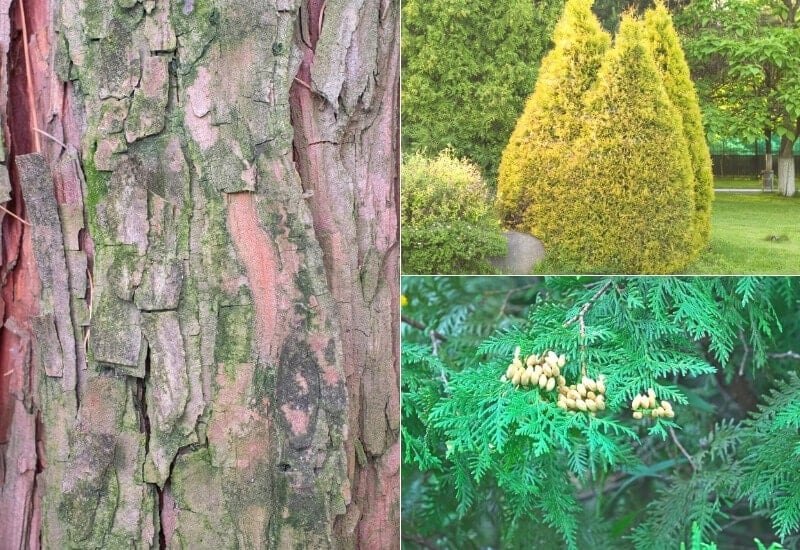
Eastern white cedar, also known as American arborvitae, has a large native range in the eastern united states. This plant commonly grows in the wild and in residential and commercial settings.
The dense foliage of this tree makes it a top choice for privacy screening. That foliage consists of bright-green scale-like needles. It can also grow very tall, sometimes over 60’.
Eastern white cedar typically has a single trunk and a conical form. At times it is slightly pyramidal.
The wood of this tree is rot-resistant making it useful in construction. This use goes back to the indigenous people of North America who used this tree to build canoes.
Identification
Planting and Care
Prune eastern white cedar in spring or summer. This tree can tolerate shearing.Generally, this tree prefers neutral to alkaline soils and areas of full sun.Eastern white cedar is a great option for year-round privacy hedges or windbreaks.
Thuja Plicata (Western Red Cedar)
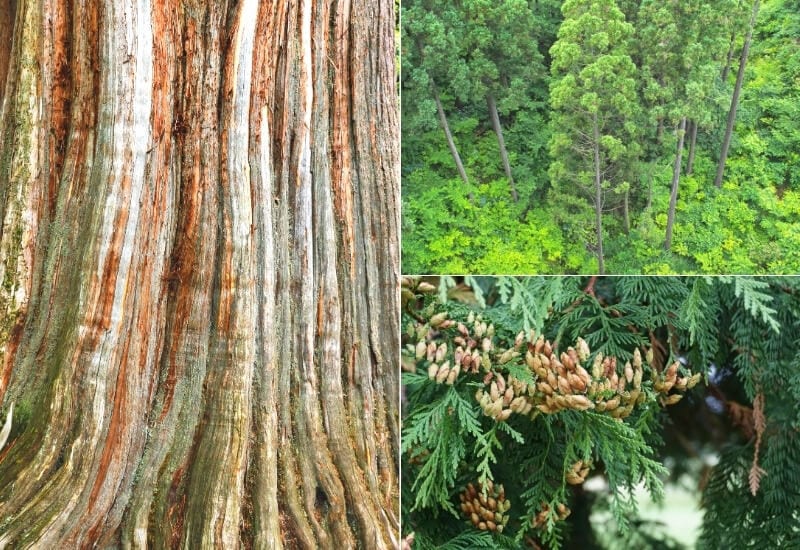
Western red cedar is native to the Pacific Northwest. It is common in cool coastal locations.
Much like the eastern white cedar, western red cedar has wood that is fantastic for building. It is one of the most commonly used woods in carpentry.
Because it is so massive, western red cedar is sometimes called giant red cedar. It can reach hundreds of feet tall but it maintains a narrow pyramidal shape.
Like other arborvitaes, this tree can contribute to a quality hedge. But many consider this to be one of the most attractive cedars, so it is suitable as a specimen as well.
The leaves are dark green and lustrous. They consist of small scales. In areas of extreme sunlight and heat the leaves can turn brown at times.
While being extremely large, western red cedar is also long-lived. In ideal conditions, their lifespan can exceed 1000 years.
Identification
Planting and Care
Western red cedar prefers cooler areas with moist soils. But, it can both partial shade and full sun. The soil should have a neutral ph.
Prune in late winter. Pruning in spring can cause bark damage that will lead to disease.
Remember this is a large plant so provide plenty of space. Use pruning to thin branches as needed.
Hemlock Trees
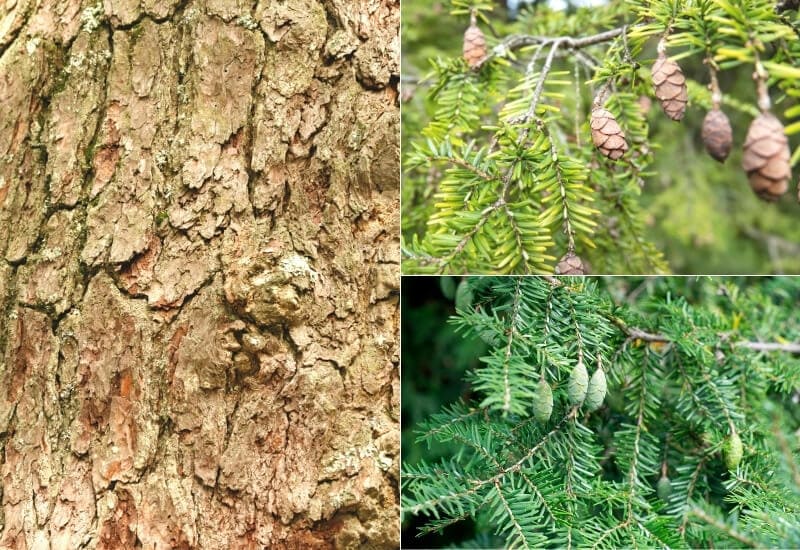
The story of hemlock trees is a relatively sad one. Currently, there is a pest called the wooly adelgid that threatens to wipe out the entire population of hemlocks. But that does not exclude them from our list. Not only are these trees an essential part of their ecosystems, but they are also some of the most attractive evergreens around.
Tsuga Canadensis (Canadian Hemlock)
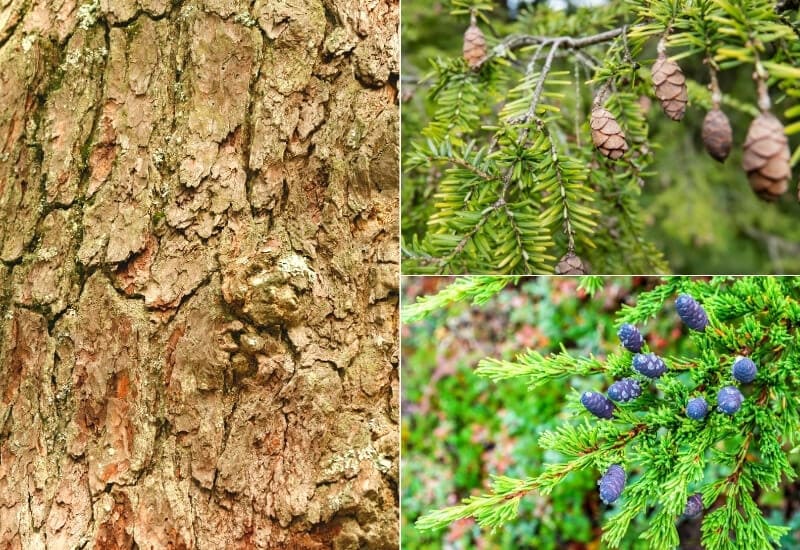
Canadian hemlock is a pyramidal conifer native t north America. It tends to grow in moist woodland areas often near bodies of water.
The short needles appear in regular intervals along each branch. They have a deep green color. On their bottom sides, they have two whitish bands.
The whitish bands are not to be confused with wooly adelgid. This pest threatens the entire Canadian hemlock species.
This tiny insect attaches itself to the underside of Canadian hemlock leaves. It then sucks out the tree’s moisture. As it does, the insects become engorges. In aggregate, they create a wooly appearance.
This pest is an unfortunately common identification feature. Canadian hemlocks are currently dying off as a result.
Despite this major issue, Canadian hemlock is a very attractive evergreen tree. In addition to the foliage, it has pleasing bark. That bark is flakey in youth and dark with deep furrows at maturity.
Identification
Planting and Care
Canadian hemlock grows best in cool, moist, acidic soils. Areas of the full sun are not ideal, but the tree may still survive.This tree is very responsive to pruning. As such it is useful as a hedge.
Avoid pruning in winter. Instead, prune in spring or early summer. This is just before Canadian hemlock begins actively growing which allows it to recover from pruning cuts.
Tsuga Heterophylla (Western Hemlock)
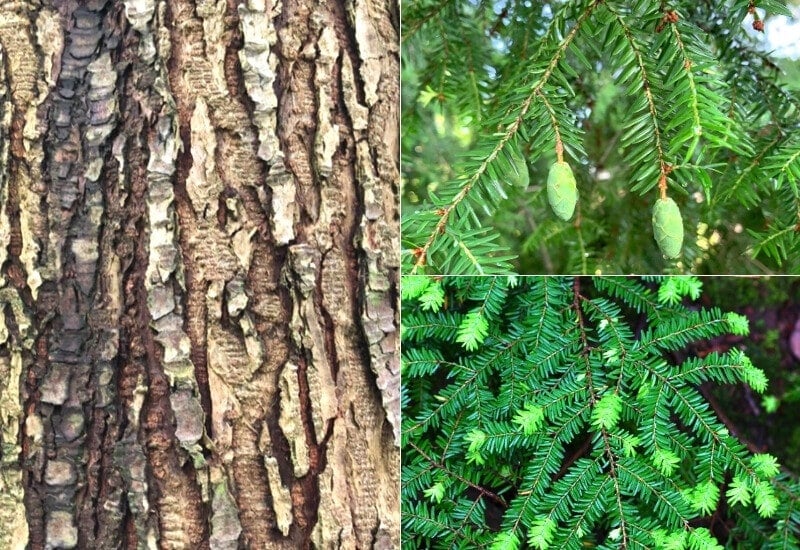
Western hemlock is the largest of any hemlock tree. It soars to extreme heights. All the while it maintains a very narrow form.
The bark of this tree grows in ridges and is reddish-brown. The branches have a tendency to be slightly pendulous.
The needles are short, only about ¾” in length. They are dark green and can have some white on the bottom.
This plant thrives in the mountains but can tolerate some urban conditions too. Unfortunately, the wooly adelgid is a significant threat as with the Canadian hemlock.
Identification
Planting and Care
Avoid sunny areas when planting this tree. Anticipate an enormous mature height.
Western hemlock prefers shade, moisture, and low ph.
Prune in late winter to early spring just before growth begins.
Holly Trees
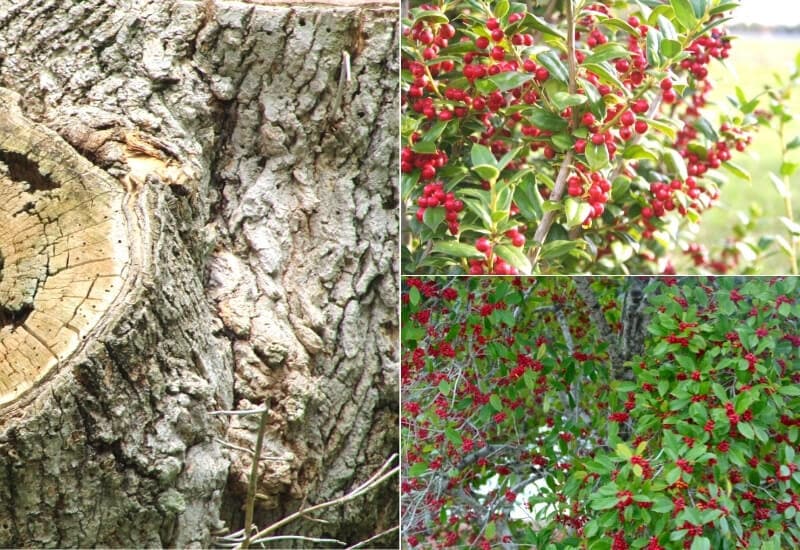
Although hollies are more common in shrub form, they grow as trees as well. They are also an example of broadleaf evergreens. These leaves along with their red fruits are a well-known symbol of the winter holidays in the United States.
Ilex Opaca (American Holly)
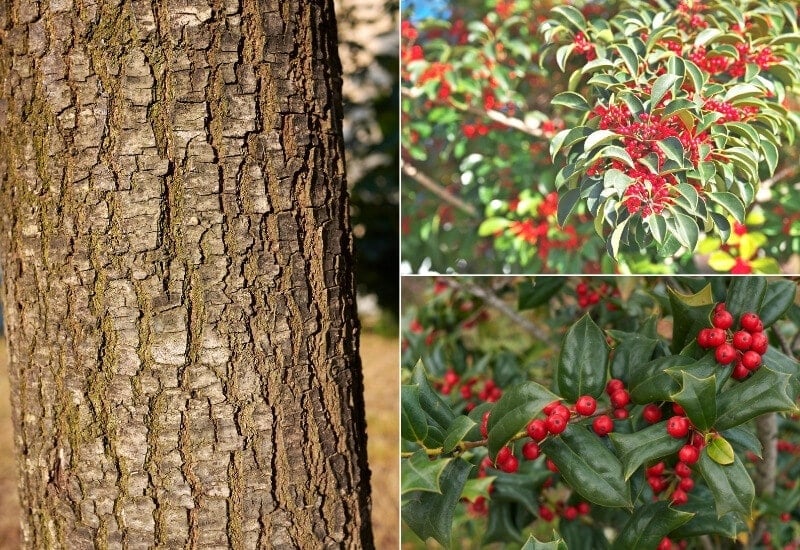
American holly is a broadleaf evergreen. It often grows as a shrub. However, it is capable of becoming a small tree, reaching heights around 30’.
To many, American holly is symbolic of the Christmas season. The leaves and bright red fruits make for festive holiday decorations.
The leaves are green sharp. They feature about nine points each.
American holly branches close to the ground and has a cylindrical to pyramidal shape. As it ages it can become a bit more open and loose in its form.
As mentioned before, the fruits are very attractive. Their red color makes them highly noticeable especially as they persist into winter.
Identification
Planting and Care
Plant American Holly in moist acidic soil. Sunlight requirements vary from full sun to part shade.
Plant as a hedge or as a foundation plant. Expect fruits to attract birds in winter. Consider adding wind protection to avoid damage from heavy winter gusts.
This plant has both male and female versions. Don’t prune too late in summer.
American holly buds grow on old wood. So by pruning before this plant blooms, you risk reducing the total amount of flowers and fruits.
The best time to prune is as the flowers are turning to fruits. This often occurs in summer.
Ilex Aquifolium (English Holly)
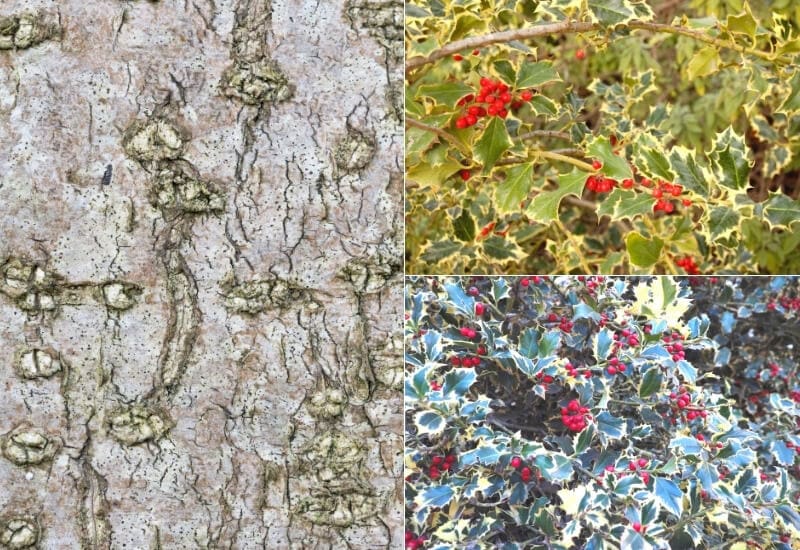
English holly is a broadleaf evergreen hailing for Europe and western Asia. It can also grow in some regions of northern Africa.
This tree has a dense branching habit. With pruning, this pant can remain as a shrub. More often it grows to be a tree between 30 and 50 feet.
The leaves are dark green. They have a leathery texture and an undulating margin. That margin has multiple sharp points as well.
While the flowers bloom in May with a strong scent, they are nearly unnoticeable due to their size. The fruits, by contrast, are extremely noticeable. Much like the American holly, they are round and red.
Identification
Planting and Care
Protect this tree from cold winter winds. Like American holly, English holly needs acidic soil and limited sunlight.
English holly is considered a more ornamental version of American holly.
Follow the same pruning guidelines as for American holly.
Juniper Trees
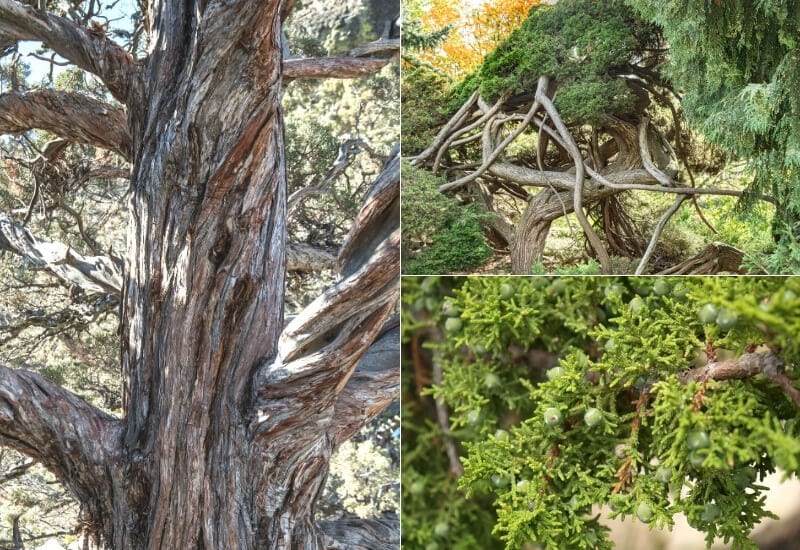
Juniper is another group of plants that can take many forms. This includes low-growing ground covers, shrubs, and trees as well. Juniper foliage is prickly and often has blue tints. The plants also show both poisonous and edible parts. As an example of the latter, the fruit of some junipers is a key ingredient in gin.
Juniperus Communis (Common Juniper)
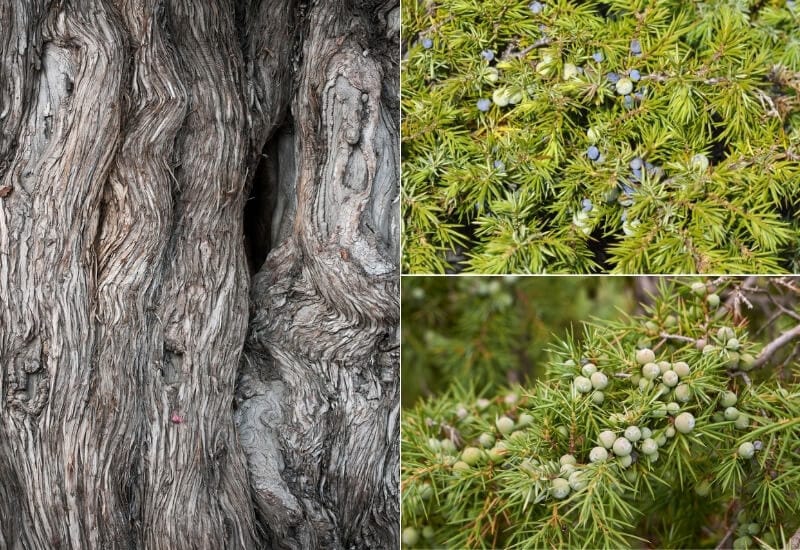
Although it is more often a low-growing shrub, common juniper can take the form of a tree. When it does, it remains a small tree at about 15’ in maximum height.
The leaves have an awl shape and are sharp to the touch. They grow from the stem at a wide angle.
The bark is reddish-brown. It often is scaly with flakes falling off as the trunk expands.
The fruit of this tree is a cone. But it looks more like a round blue berry. The flavor from this fruit gives gin its distinct taste.
Identification
Planting and Care
Common juniper is vulnerable to juniper blight.
Plant in full sun. The soil range for this plant can vary in ph.
Don’t do heavy pruning on this tree. Cutting back to far can cause foliage not to grow back. Pruning should take place in spring before new growth begins.
Juniperus Virginiana (Red Cedar)
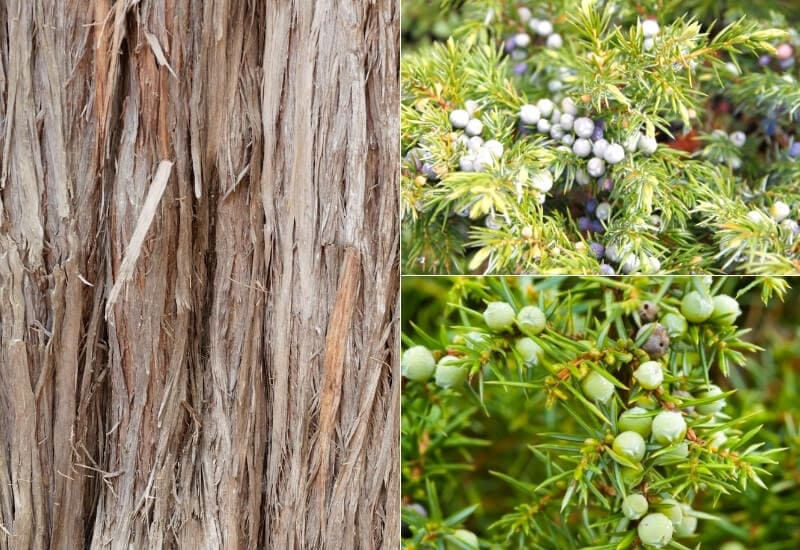
Red cedar is a part of the juniper family. Like other species sharing the cedar name, this plant has dense scale-like foliage.
It shares a similar appearance with eastern white cedar and western red cedar. But red cedar has some differences.
For example, while evergreen, red cedar foliage has some change in color in the winter. For most of the year, the foliage is green with a blue tint. In winter it can show more brown hues.
Its overall form is columnar with some pyramidal tendencies. Red cedar often presents an abundance of round blue fruits.
Identification
Planting and Care
Avoid planting this tree in close proximity to apple trees to avoid cedar apple rust.
Red cedar can adapt to a wide range of soil types. This includes variation in ph and moisture.
Prune in winter. Springtime pruning can cause bark damage leading to fungal infections.
Cypress Trees
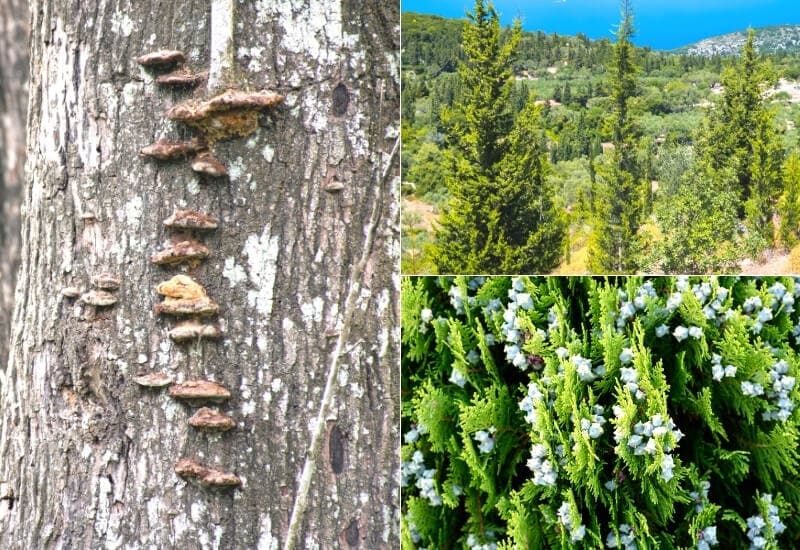
Cypress trees have been a part of western culture for centuries. They are referenced in classical literature. They are also a common feature of some classical gardens. Today these plants are popular throughout the world.
Cupressus Sempervirens Subsp. Dupreziana (Italian Cypress)
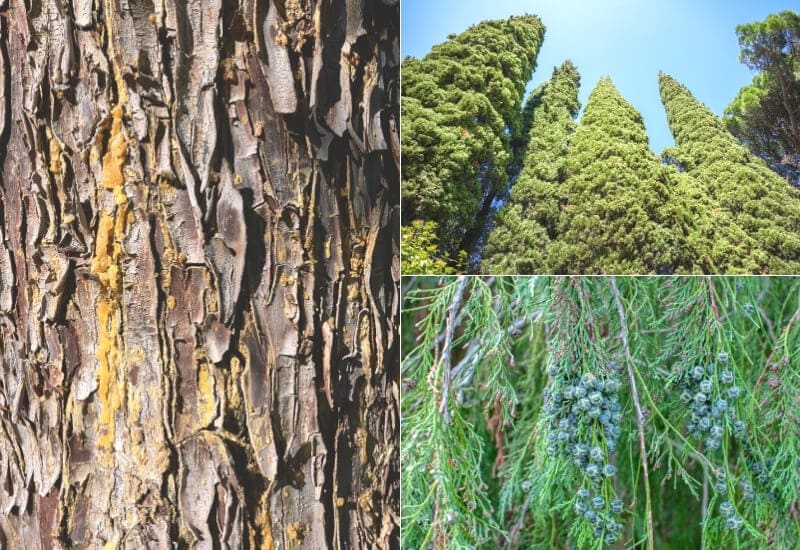
Italian cedar hails from southern Europe and western parts of Asia. It thrives most in Mediterranean climates.
This tree is known for being very narrow. While it can grow to 70’ in height. It usually remains below 20’ in spread.
The foliage is dark green and scale-like. These grow on upright branches that contribute to the general shape. When crushed, the foliage has a strong scent.
Italian cypress has been a feature of classical Italian gardens for centuries. It remains popular today growing in the United States where the climate is similar to the plant’s native range.
Identification
Planting and Care
Italian cypress presents a few issues in terms of disease and infestation.
Plant in full sun and well-drained soils. Maintain soil moisture until the tree is established. Once established, Italian cypress can tolerate drought.
Trim the tips of the branches in winter when the plant is dormant. Consider clipping the top to manage the height.
Hesperocyparis Arizonica (Arizona Cypress)
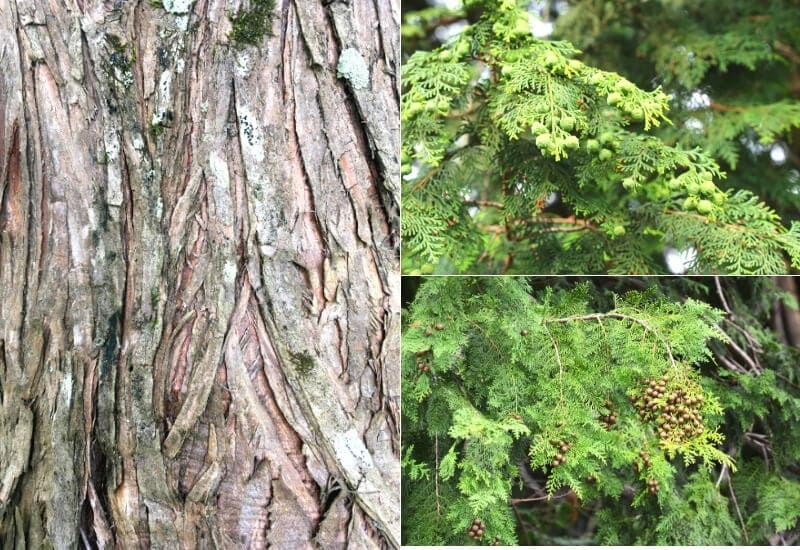
Arizona cypress grows in hot climates. Because of its ability to survive in exceptionally dry soils, it is commonly found in the deserts of the American Southwest.
This tree is very broad at the base. The canopy then tapers to a sharp point at the top.
The foliage consists of overlapping scales that form flat branchlets. In color, this foliage is often a grayish-green.
The bark is reddish-brown. The branches have a tendency to be thin and lace-like.
Identification
Planting and Care
Because of its adaptability, Arizona cypress is easy to care for. It has little to no disease problems. It also seems to be resistant to deer browsing.
This tree is a good option for privacy. Sometimes it is grown on Christmas tree farms.
Prune in spring or summer. Keep base branches wider than top branches to allow sunlight to reach all parts of the plant.
Conclusion
While some complain that evergreen trees lack variety, this list proves otherwise. While the differences between species can be subtle, each evergreen tree has its own individual character.
Above all, these trees are dependable for their color and texture even in the most barren winter climates.

Written By
John Haryasz
John Haryasz is a writer with a background in landscape architecture. His education includes a Bachelor of Science in landscape architecture from UMass, Amherst with a minor in psychology. Following graduation, John worked in a small landscape architecture office. In this role, he led many successful projects in Berkshire County, MA. After a few years, John began offering freelance design services. He has since produced designs for projects across the country. As a writer, John aims to share knowledge while promoting engagement with the outdoor world.

you have not showed me a short needle, smooth bark, ever green tree about 25 ft. tall
I really like how you set this article up, John. But the tree I am foraging for is not here. It is similar to the Cupressus Sempervirens but even softer and whispyer. And growing on it is a gigantic, what I’ll call, a pod. It’s light green and large, like a softball but oblong-ish. It’s in my neighbor’s yard. I’m seeing if maybe there is a good chance to ask him when he’s already outside. I don’t even know if he knows that ‘pod’ hangs from it. Anyway, it sure is a magnificent specimen…..
Am looking for the botanical name of an evergreen tree that grows thick, showing more than one main trunk when it becomes taller than about 12 ft. Coloring is green with a hint of blue to it.
Has soft sharp needles when young that mature to extremely hard sharp needles.
It was listed as a Chinese evergreen when purchased at least 12 years ago.
I am in zone 7
Have not had any cones on it.
I’m looking for a tree that looks like some kind of evergreen. It grows tall and thin and looks like something out of who-Ville. Anyone know?
Email me at: [email protected]
It sounds like you might be describing a “Whoville” tree from the Dr. Seuss storybooks! While these fictional trees don’t exist in real life, there are some tree species that have a unique and whimsical appearance that might be similar to what you’re looking for.
One example is the Pencil Pine (Cupressus sempervirens ‘Glauca’), which has a tall and thin growth habit and a narrow, columnar shape. Its blue-green foliage can give it a unique and striking appearance.
Another option is the Italian Cypress (Cupressus sempervirens), which is also known for its tall and narrow growth habit. Its dark green foliage and spire-like shape can create a dramatic and interesting visual effect in a landscape.
If neither of these options are quite what you had in mind, you might consider consulting with a local nursery or landscaping professional who can help you identify and select a tree species that matches your vision.
Nice article but our trees aren’t there either . They appear to have no fruit at all . They are untidy but grow slowly . Two have grown together and we built a deck underneath . May I send a picture ?